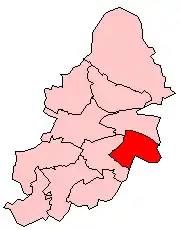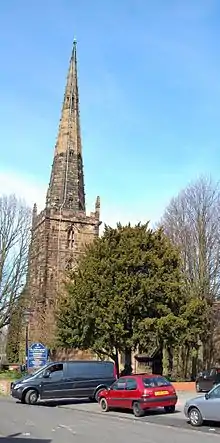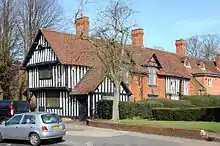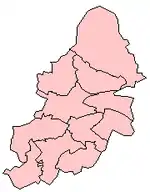Yardley, Birmingham
Yardley is an area in east Birmingham, England. It is also a council constituency, managed by its own district committee. Historically it lay within Worcestershire.[1]

Birmingham Yardley is a constituency and its Member of Parliament is Jess Phillips, elected in May 2015.
Features

Yardley's main shopping area is known as Yew Tree, named after the yew that stood, originally to the south of the roundabout, outside what was then Boots, then on the roundabout at the junction in the centre of Yardley. It was damaged during work to the roundabout, and as a result was removed. It was later replaced by another tree located in the centre of the island.
In 2012, the Swan Shopping Centre was opened in the area serving the Yardley area in the place of the old Swan Centre which used to hold markets.
History
Yardley is not a town. Yardley is named in the Domesday Book and was referred to as early as 972 in King Edgar's Charter where it is named Gyrdleah. It was mentioned as being under the possession of Pershore Abbey.
The parish of Yardley, historically part of Worcestershire, became the only parish in the Yardley Rural District under the Local Government Act 1894, and was added to Birmingham and Warwickshire in 1911.[2] The ancient parish of Yardley included the areas known as Stechford and Hall Green. The area of Gilbertstone straddles the border of Yardley and South Yardley.
Yardley has a Tudor hall called Blakesley Hall and an old church, St Edburgha's, that dates back to the 13th century, with the church tower and spire dating to the 15th century. It was not established by the abbey, but by Aston Church in the Diocese of Lichfield.[3] A Tudor addition to the church is a doorway surrounded by Tudor roses and a pomegranate, commemorating the marriage of Prince Arthur, Prince of Wales, to Catherine of Aragon.
Yardley had a manor that was owned by various lords. It remained unoccupied from 1700 onwards. It was owned by the Royal Family until 1626, when it was bought by Richard Grevis of Moseley Hall. His descendants sold it in 1759 to pay off debts. John Taylor, one of the founders of Lloyds Bank, bought the lordship in 1766. Most of the land, had by then, been purchased by other people so Taylor owned only a small portion of the original grounds.[3]
A small section of Yardley, called Old Yardley, was granted conservation area status in 1969, becoming Birmingham's first conservation area.[4]
In 1981, an Arcon V prefab home on Moat Lane was dismantled and transported to Avoncroft Museum of Historic Buildings.[5]
Yardley also contains a moated medieval site called "Kent's Moat". Now dry, it has retained its depth and shape remarkably well considering its age, as excavations have shown evidence of inhabitation from as early as the 12th century.
Education

Yardley has five main primary schools. These are Yardley, Blakesley Hall, Lyndon Green, Oasis Academy Hobmoor and St. Bernedettes. It also has two main secondary schools, which are Cockshut Hill School and King Edward VI Sheldon Heath Academy.
Hobmoor Primary School moved to new premises in Summer 2007. The former building has been demolished and the site remains vacant to be redeveloped.
Transport
Yardley's nearest railway station is Stechford railway station. It is served by National Express West Midlands bus routes 11A, 11C, 17, 58, 60, 73, X1 and X2, connecting to Birmingham city centre, outer circle, Chelmsley Wood and Solihull and Claribel Coaches route S16.
The area used to be well-served by horse-buses and then by steam buses. Electric trams were then introduced and they travelled across a new bridge at the River Cole to the Swan.[3]
References
- https://wikishire.co.uk/map/#[email protected],-1.817/centre=52.467,-1.817/zoom=14
- GB Historical GIS / University of Portsmouth. "Yardley RD through time | Census tables with data for the Local Government District". A Vision of Britain through Time.
- Images of England: Yardley (Introduction), Michael Byrne, 2002, Tempus Publishing (ISBN 0-7524-0339-7)
- "Birmingham UK Com". birminghamuk.com.
- Stratton, Michael (2000). Twentieth Century Industrial Archaeology. Taylor & Francis. p. 36. ISBN 0-419-24680-0.
External links
| Wikimedia Commons has media related to Yardley, Birmingham. |
- Birmingham City Council: Yardley Constituency
- History of Yardley
- 1888 Ordnance Survey map of Yardley
- Yardley in the Domesday Book

